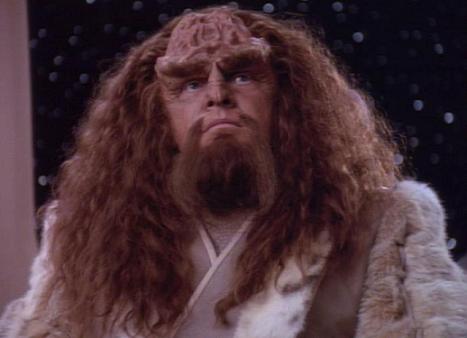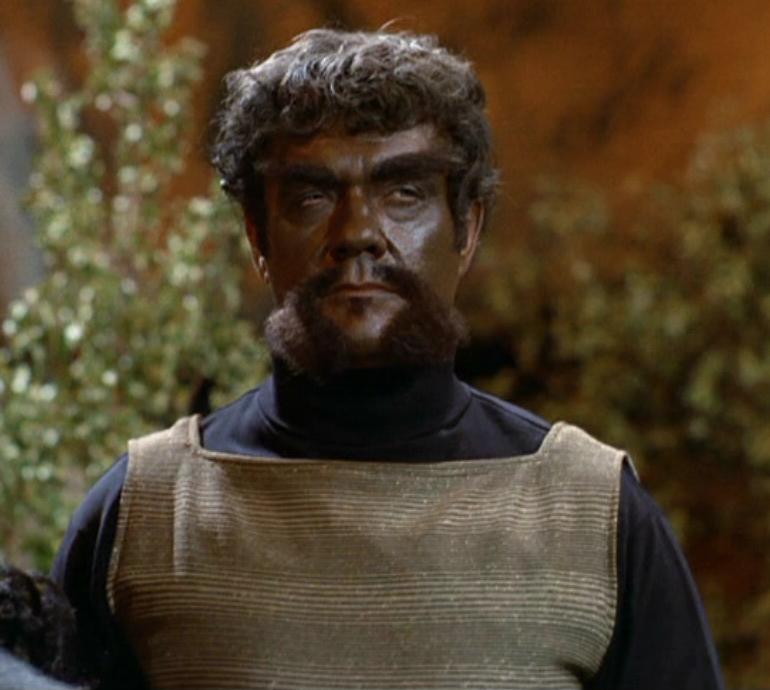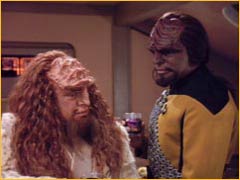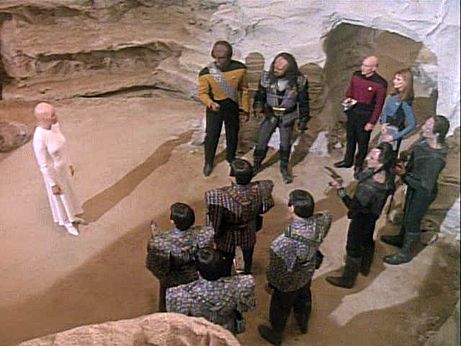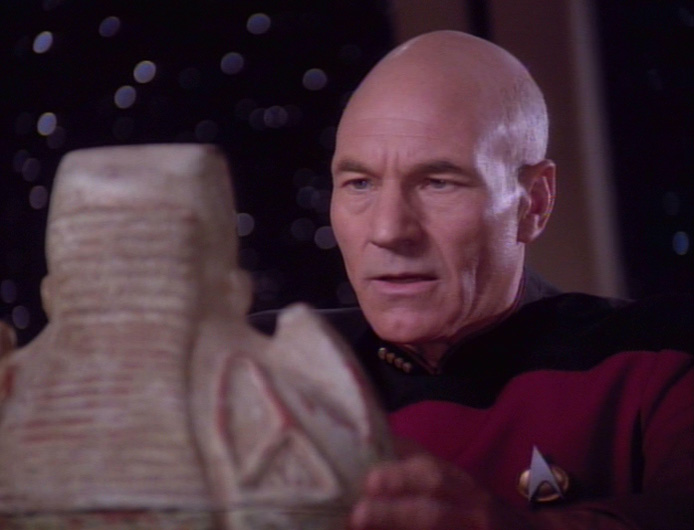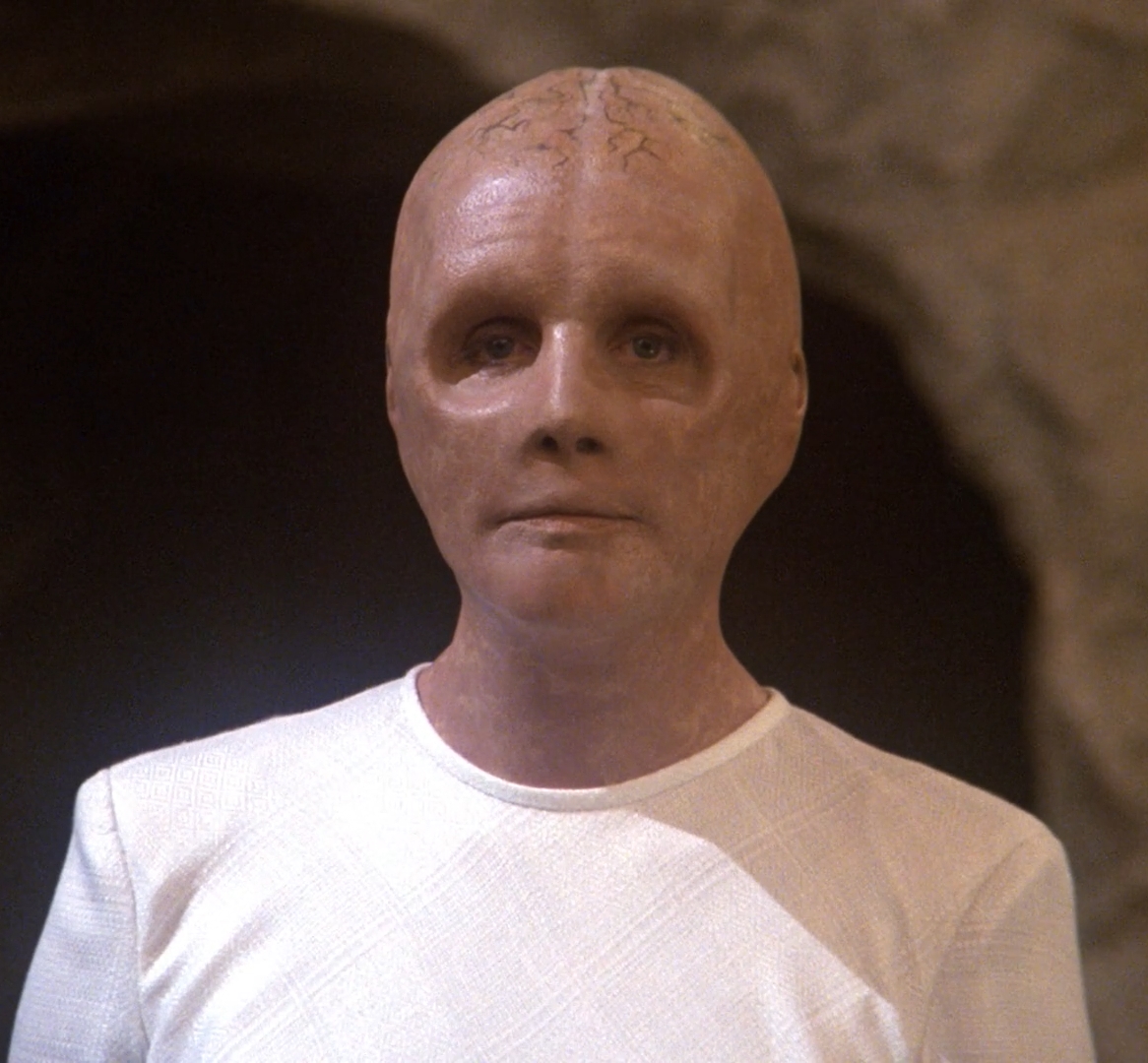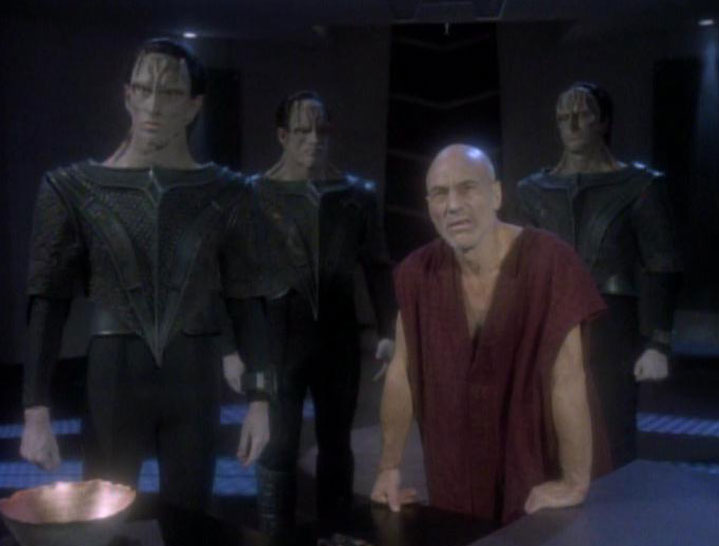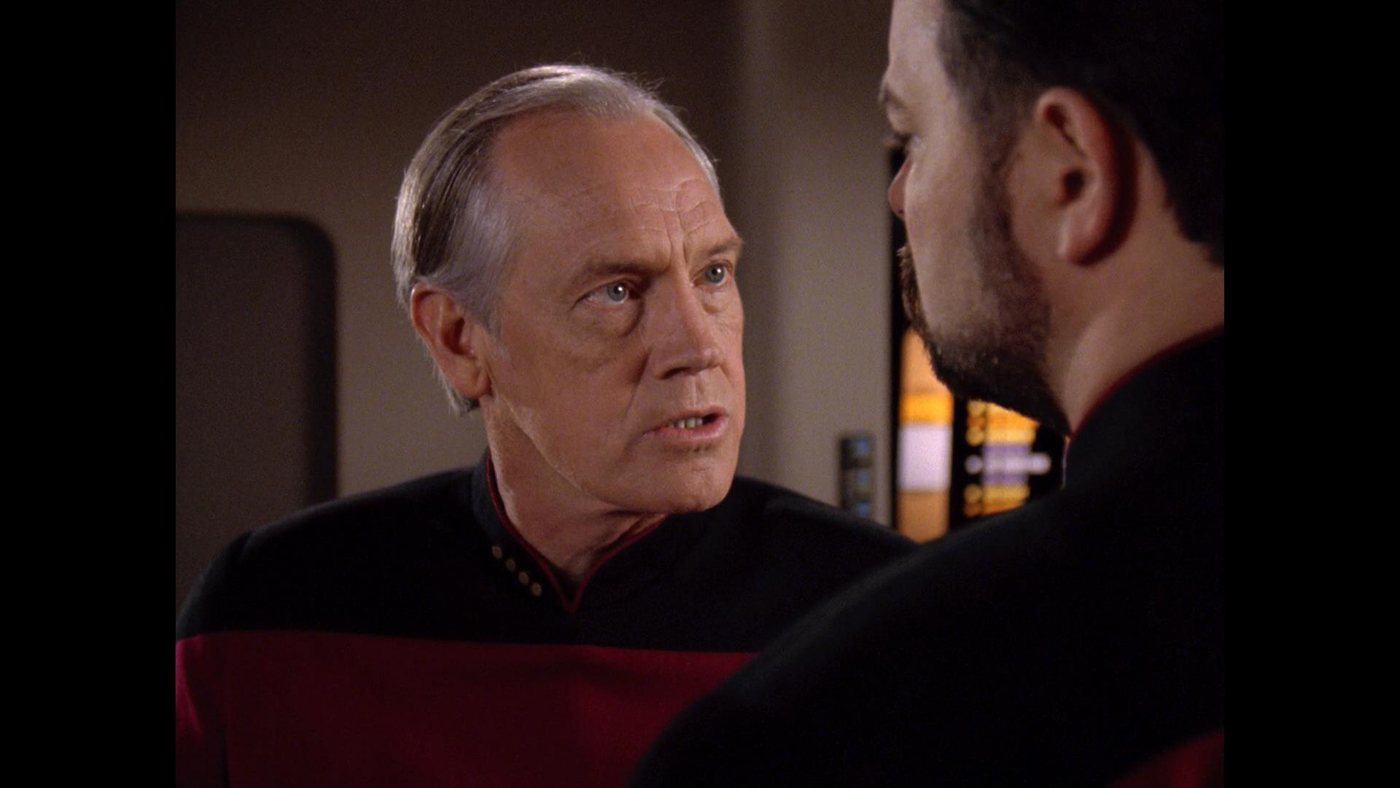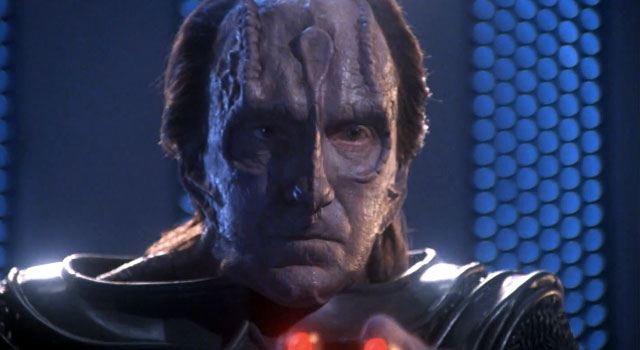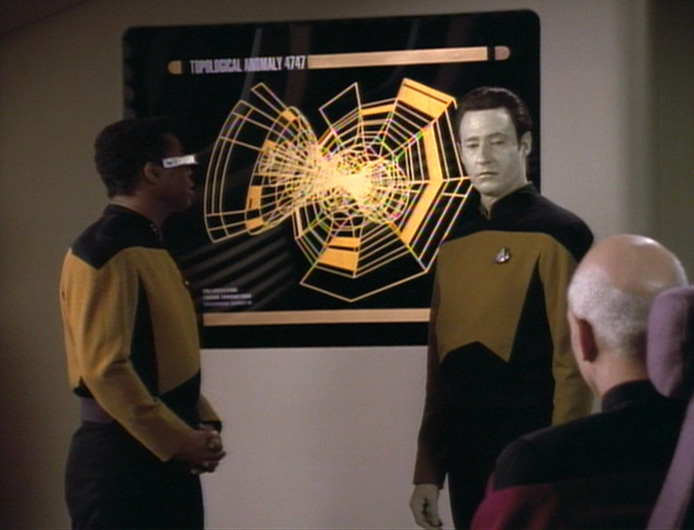
Part I: The Borg are back, but they exhibit individuality and emotions. Data, too, during an early encounter gets angry — and even feels pleasure when he kills a Borg. As the Federation prepares for a new Borg invasion, a captured Borg (Brian Cousins) convinces Data to steal a shuttle to meet “the one” who will give him more emotions. The Enterprise follows, and Picard sends pretty much everybody on the ship except for Spot and the fish in the ready room to look for Data on a remote planet, leaving Crusher (!) in command. After a brief search, Picard, Troi and La Forge are captured by the Borg, who are led by our favorite evil twin, Lore (see “Datalore”). Data then emerges, and tells Picard that he and Lore will together “destroy the Federation.”
Part II: Picard and Co. are prisoners, and it’s clear that Lore’s done something to Data to make him act all evil while feeding him emotions from the chip he stole from their creator, Dr. Noonien Soong (in “Brothers”). Lore has Data experiment on La Forge as part of a plan to make the Borg fully artificial. Crusher recovers most of the Enterprise crew from the surface, but Riker and Worf stay behind to try to find Picard’s team. They run into Hugh (Jonathan Del Arco) from “I, Borg”, who tells them his individuality caused chaos within the Borg, who were then manipulated by Lore. Crusher on the Enterprise defeats a Borg ship in battle, and Riker and Worf mount a rescue — in which Hugh and his buddies reluctantly help. Data, whose ethical subroutines have been reactivated, MacGyver-style, by Picard and Co., rejoins the good guys and deactivates (and later disassembles) Lore. La Forge, back on the Enterprise, is fine, and stops Data from destroying the recovered emotion chip.
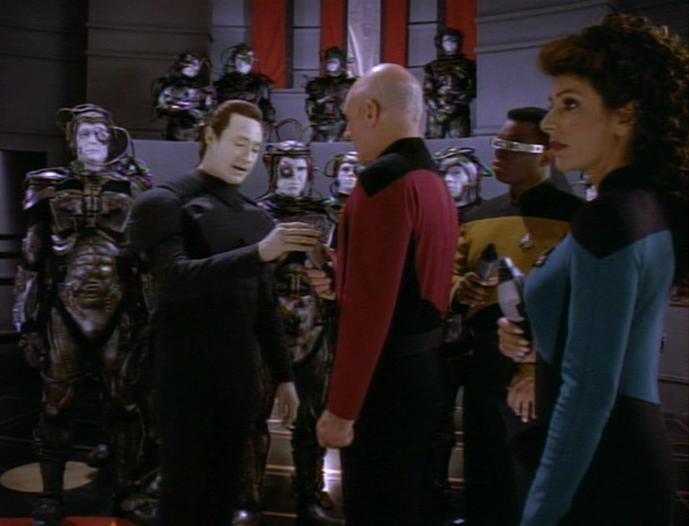
Why it’s important
You might think part one is one of Trek’s most consequential hours. It’s a good piece of TV and ties in a lot of threads from past storylines. But part two — in which we learn that only a subset of the Borg is part of Lore’s plan — kind of kills the consequences of part one. Other than those we see here, the Borg are largely unaffected by what happens in these episodes (and by Hugh, previously) and go about their merry way of trying to assimilate the galaxy. We see them back in their collective form in “Star Trek: First Contact” and starting in the third season of Voyager.
Really, the recovery of Data’s emotion chip is the bigger domino. In “Star Trek: Generations”, Data decides to use the chip — with disastrous (early) results. Cowered by fear, Data lets Dr. Tolian Soran escape. Later, Soran successfully draws the Nexus time event to him in the Veridian system by destroying that system’s sun. Picard, caught in the Nexus, goes back in time and stops Soran with the help of James T. Kirk, who had been caught in the Nexus for nearly 80 years. Picard and Kirk are successful, but Kirk is killed. And the Enterprise-D is destroyed.
Data, of course, has emotions for the remainder of the Trek movies, as he’s able to (mostly) master them. Sure makes you wonder why he and La Forge didn’t test the chip in a more controlled environment, as we’ll get to that when we review “Star Trek: Generations”. Get ready for an epic rant, people.
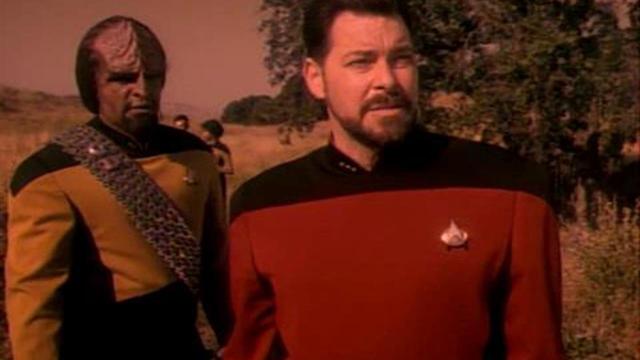
What doesn’t hold up
Part one deals a lot with Picard’s decision to send Hugh back to the Borg without the destructive program Data and La Forge designed. Admiral Nechayev (Natalija Nogulich) rakes him over the coals for the move. My only real gripe there is that Picard didn’t have this kind of dressing down earlier, if he was going to have it at all. We’ve seen Nechayev before (in “Chain of Command”) so it’s odd that she hasn’t addressed her concerns previously — and only does so when it provides necessary exposition here.
Otherwise, Picard’s decision to send nearly the entire crew to look for Data was just ridiculous. It all works out in part two, but the Federation flagship was facing a Borg vessel with an untested ensign at tactical and the chief medical officer in command! The idea, I guess, was to line things up to give Crusher a shot in the big chair — and Gates McFadden was up to the challenge — but Picard’s logic was just awful here.
Part two, actually is even worse — both as far as logic and entertainment value. To start, Picard and Co., simply are able to do way too much with limited resources while in a Borg holding cell (with no apparent surveillance). That they could reactivate Data’s ethical subroutines with a piece of gum, some tin foil and a lot of luck was hilariously bad writing.
Then, there’s the clear retrench by the creators between the two episodes. In part one, the obvious implication is that the ENTIRE Borg collective had been affected by Hugh. There’s no discussion or pondering over whether the new individualized Borg are anomalies. But in part two, near the end, Hugh makes a comment that they “can’t go back to the collective.” Initially, I took this to mean that all Borg, now individuals, couldn’t recreate the collective. But, apparently, it meant that the collective still existed and the Hugh-affected Borg were separate of it. Why they can’t rejoin the collective isn’t explained.
Why only some Borg were affected by Hugh, of course, is never explained. The whole POINT of the Borg is that they’re interconnected. But by limiting Hugh’s effect to the Borg we see here, the Borg as we knew them are still around as a threat. My guess? The creators realized after part one that they wanted to keep the old Borg around and they undid some of the consequences from part one — even though they had to do it with what only could be called “weak sauce.” Yuck.
I suppose I could bitch about how Lore found the Hugh-affected Borg in the first place. The last time we saw Lore, he had a small ship and was leaving a planet in or near Federation space. So, either the Borg ship with Hugh on it was in or near Federation space — which comes back to the whole question of where the Borg are and why they don’t attack the Federation more often if they’re close by — or Lore was able to travel a VERY long way from Federation space and just happened to stumble onto the Borg and THEN take them to the Delta Quadrant, home to the planet we see in this episode. Either way, it’s a mighty small galaxy, after all.
Lastly, why does Riker tell the Enterprise crew still on the planet to take cover and not assist him and Worf? Granted, a larger group would have been easier to spot, but Riker could have called for the other officers before he mounted the attack on Lore’s compound and not had to go in with awful odds. Or, maybe more significant, having even four or five more officers would have helped Riker and Worf without compromising their position. My guess is the budget for extras was already overly taxed.
Oh, and one more thing. Does anyone else find it odd that Data — whose rights as a sentient being have been a major thread of TNG — is cool with essentially executing Lore? In second-generation Trek, there’s no indication that the Federation is down with the death penalty, but Data makes the conscious decision to disassemble Lore at the end of this episode. The creators made this harder on themselves than was really necessary, as Lore could have been damaged beyond repair when Data shot him near the end of the episode. I understand why imprisoning Lore would have been damn-near impossible. But by having Data disassemble Lore, he treats his brother like a piece of equipment — the very thing that was the whole point of “The Measure of a Man”.
Final thoughts
Season six of TNG was arguably its best, but season seven is arguably its worst. While “Descent I”(the final episode in season six) isn’t perfect, it’s a fun watch, but “Descent II” (the first episode of season seven is really bad. There are a lot of weak showings in season seven, with a few good ones thrown in. In retrospect, it seems pretty clear that the series was running out of gas, as season seven has a lot of off-the-wall outings (“Masks”, “Thine Own Self”, “Emergence”, the crap with Troi and Worf and the abysmal “Sub Rosa”).
Basically, season seven gets points over the first two seasons because the characters are less erratic and because the finale (“All Good Things …”) was so strong (so were “The Pegasus”, “Parallels” and “Preemptive Strike”). But I’d rather watch most first- or second-season episodes than about two-thirds of season seven.
Last point: This is another example of our heroes having some really bad stuff happen right at the end of a calendar year. With the decision to make a full season a full year (e.g., the sixth season is 2369 and the seventh season is 2370) the entire incident with the Lore-led Borg happened right around New Year’s Eve. This approach really began with “The Best of Both Worlds” two-parter — that set in motion season-ending cliffhangers. With some exceptions, this was the approach for most of TNG, all of DS9 and all of Voyager.
Coming next week …
So, THAT’s why the Federation doesn’t use cloaking devices.

